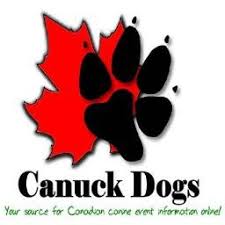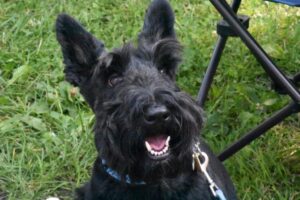Written by Cindy Cooke
Provenance of Janet Tomlinson, Historian
The Scottish Terrier is often described as the oldest breed in Scotland, but no one can accurately determine exactly how the breed evolved. Few outsiders were interested enough in the highland dogs to research and write about them until the late 1870s when Capt. W. W. Mackie spent several winters touring Scotland to see Scottish Terriers in their native habitat. Mackie, who described himself as having “terriers on the brain,” kept a diary in which he described the many types of dogs that were all described as “Scottish” terriers. According to Mackie’s diary, every highland community boasted a gamekeeper or a deer forester who kept a pack of terriers to rid the community of foxes, otters, weasels, stoats, rats and other vermin. The dogs varied widely in size, color and ear carriage, but every terrier man in the highlands of Scotland thought his own strain of dogs was the best and the truest Scottish Terrier.[1] Mackie already had a mental picture of the correct type of Scottish Terrier:
They have a thoroughly Scottish look about them, and would shame two-thirds of the “messans” we sometimes see on the show-bench. They are of divers colours, from a grizzly brindle to sandy; in weight they will run from 17 to 20 lbs; knowing-looking big heads, sharp muzzles, powerful jaws, very large teeth, ears semi-erect, or “cock-and-a-half cock”; stout bony legs, the fore ones slightly bent. If these little dogs have any faults, I would say the fault lay in their ears being heavy, and their tails being inclined to curl slightly.

Eng. Ch. Kildee
Mackie’s trips to Scotland coincided with the beginning of dog breeding and exhibition as a hobby in England. He is estimated to have brought around 60 Scottish Terriers back to England, and by 1885, he was exhibiting two of the most successful show dogs of the day, Ch. Dundee, one of the breed’s two founding sires, and the top-winning bitch, Ch. Glengogo.

Eng. Ch. Dundee, one of the two founding sires of the breed.
Dog shows popularized many breeds that were formerly not considered suitable as companion animals. The Scottish Terrier was one such breed. Unsociable and inclined to bite first and ask questions later, it is amazing that the breed caught on with the public at all, but it did. By the 1930s, the breed was wildly popular both in Great Britain and the United States. Two important British kennels were producing most of the top dogs on both sides of the Atlantic. The first was Albourne, a kennel owned by A. G. Cowley. Mr. Cowley sold horses to the Army during WWI, so during the years when many breeders cut back because of food shortages, Cowley had plenty of meat to feed his many dogs. The second was the famous Heather kennel owned by Robert Chapman, Jr. The Chapmans had a multitude of tenants on their land, and many of them raised the Heather puppies as a condition of their tenancies.
In the US, Scottish Terriers were also one of the most popular breeds. Scotties appeared in novels, magazines, movies and every sort of collectible item imaginable. With American fanciers paying thousands of dollars for imported Scottish Terriers during the years between the World Wars, English breeders were unable to resist the lure of so much money. For the first time in the breed’s history, breeders were selecting their stock on the basis of what the show fanciers wanted rather than for working traits. Almost overnight, the English breeders produced a new style of Scottish Terrier. The new type had a shorter body and more profuse hair on the face and legs. The two dogs pictured below were the most influential sires of that era and are credited by most authors with establishing the modern Scottish Terrier.

Eng. Ch. Heather Necessity

Eng. Ch. Albourne Barty
As the English breeders began to accept the inevitability of a second World War, many sent their best dogs to the United States to protect them. American Scottie breeders benefited significantly from the arrival of the best British Scottish Terriers. Roosevelt’s Fala kept the breed in the public eye, so the breed remained popular.
When WWII ended, and prosperity returned to the United States, the hobby of dog showing was no longer the exclusive province of the wealthy, as it slowly became a popular middle-class family activity. The large breeding kennels of the 30s and 40s evolved into family kennels, with smaller numbers of dogs. Improvements in transportation gave small breeders access to stud dogs located anywhere in the country.
As the breed evolved over the decades from a small, fierce hunting terrier to a show dog and family companion, the changes were reflected in the English and American breed standards. The first breed standard, drafted in 1880 before there was an official Scottish Terrier club, was the result of months of intense debate in the dog publications of the day. The so-called Morrison standard called for a “thick‑set, compact, short‑coated, active terrier, standing about nine and a half inches high, with body of moderate length and averaging about sixteen to seventeen pounds weight for dogs and two pounds less for bitches.”
When the Scottish Terrier Club of England formally adopted a standard, just 8 years later, greater latitude was given in height: from 9 to 12 inches. Eighteen pounds was considered ideal for a male and 16 pounds for a bitch, with a range of 15-20 allowed. When the Scottish Terrier Club of America was formed in 1900, it adopted the same height and weight standards. Both the English and American standards described the body as “of moderate length, but not so long as a Skye’s.”
It is important to consider the meaning of “of moderate length,” since the issue of Scottish Terrier body length continues to be somewhat controversial. Below are three illustrations of 19th century terriers accompanied by the language of their respective breed standards regarding body length:

Body – Pre-eminently long and low…
STANDARD OF POINTS OF THE SKYE TERRIER CLUB (SCOTLAND)
as printed in W.D. Drury’s “British Dogs,” 1903

Back – Should be short, straight, and strong…
STANDARD OF POINTS OF THE FOX TERRIER CLUB (ENGLAND)
as printed in W.D. Drury’s “British Dogs,” 1903

Body – Of moderate length, but not so long as a Skye’s.
STANDARD OF POINTS OF THE HARD ‑ HAIRED SCOTTISH TERRIER CLUB (SCOTLAND)
as printed in the first Scottish Terrier Stud Book, 1887
The first revision to the American Standard, written in 1925, set the height at “about ten inches at the shoulder.” Back length was still described as “moderately short,” but the comparative reference to the Skye Terrier was deleted. When the 1925 standard was published in the AKC Gazette, the article was illustrated with pictures of the top-winning Scottish Terriers of the day. Furthermore, the words used to describe these dogs include “compact,” “cobby, “ and “correct body type.” The 1925 standard made some other significant changes, including the elimination of hazel eyes and half-prick ears.

Champion Bentley Cotsol Lassie

Champion Fairwold Ornsay Bill

Champion Lochtay Invader

Champion Fairwold Plaid
When the English breed standard was revised in 1933, the drafters followed the example of the Americans by eliminating hazel eyes and half-prick ears. In addition, they made a dramatic change to tail carriage. Up to now, all standards pretty much used the same language regarding the tail: “should be about 7 in. long, never docked, carried with a slight bend and often gaily.”
 |
| Correct tail carriage in 1900 |
 |
| Correct tail carriage in 1933 |
The new language, however, called for the tail to be “set on with an upright carriage or with a slight bend.” Finally, the 1933 revision reflected the increased size and weight of the popular show dogs of the day. The 1933 English standard, while making no height recommendation, called for a dog “of a size to get to ground,” weighing from seventeen to twenty-one pounds. Scottie purists objected to the new style of Scottie. English breeder and author Dorothy Casperz described the great Eng. Ch. Heather Necessity as “Falstaffian.”
In the United States, breeder, columnist and author Fayette Ewing wrote this critique of the modern Scottie when complimenting a judge:
“It was evident that in his placements, Mr. Reeves learned toward the working type, the dog that the founders had in mind when they made the Standard, a dog just a little more active and rangy than the one that has come to be the ideal of the most successful breeders of our day. For this he is to be commended; it is what this writer has long advocated for the salvation of the breed: a dog active enough to get over ground; game enough to fight a varmint; small enough to be a handy house-pet and at the same time go to ground and do the business for which he was created. But this fight that I have made so long I realize is a losing fight. For good or ill, the Scottish Terrier is to become a show picture, something different from the rest of the Terrier tribe, a distinct personality but withal unworkable though admirable, lovable, and attractive. This writer will continue to advocate moderation…”
In 1947, the American standard was revised again. Although American tail carriage had changed as a result of the steady parade of dogs imported from England, Americans did not adopt the “upright tail” language in their new standard. They did, however, make three important changes. First, the new standard allowed a level bite. In a letter, A. G. Cowley wrote to Dr. Fayette Ewing, he offered the opinion that this resulted from Americans misunderstanding what the British meant by “level.” In England, the term “level” when applied to a dog’s mouth meant that the incisors formed a straight line, perpendicular to the line formed by the molars and premolars. Cowley may have been right, but the acceptable (but not preferred) level bite was in the American standard to stay.

Champion Deephaven Red Seal
The second important revision was an attempt to clarify Scottie gait as viewed from the front. Unfortunately, the drafters chose to describe the Scottish Terrier gait as being “peculiarly its own.” The regrettable result of this was that some observers accepted any “peculiar” gait as the correct one.
The final and VERY important addition to the 1947 standard was the requirement for every Scottie to demonstrate real terrier character in the ring. By prohibiting judges from putting any dog who fails to demonstrate terrier temperament to Winners or better, the drafters of this standard created a virtual disqualification for shy or fear-aggressive dogs.
Back in England, the advocates for the smaller Scottie lost the fight. In 1950, the English Kennel Club revised the standard to allow for a significantly larger dog. Weight was increased to a range of nineteen to twenty-three pounds and the height-at-shoulder measurement was changed to “ten to eleven inches.”
The Scottish Terrier Club of England objected vigorously and in writing but to no avail. This plea appeared in the 1949 Scottish Terrier Club of England Handbook:
It is a mistake to tamper too much with fundamental things, and the Standard of a breed is fundamental. The Standards of our British breeds were drawn up by wise men, and aided and abetted by succeeding generations of breeders, the Scottish terrier became a power in the land, not only in the British Isles but in many parts of the world to which his popularity had carried him. He is world renowned, so why tamper with the basic rules laid down? If the weight were raised now, to suit those who wish to cross the T’s and dot the I’s, mark my words, in five years there will be bigger–but I much doubt better–Scottish terriers. Then it will be “up she goes again” and the grand little Diehard will no longer be a handy-sized terrier, but an awkward misfit, who will no longer be eligible to enter the category of low-legged Terriers, and may be dangerously near getting pushed into the long-legged section!! The Scot must retain his size in order to maintain type, and pray let us keep Scottish Terrier type as our main consideration.
The 1987 revision to the English standard included relatively minor changes. A short description of breed temperament was added, the muzzle was described (for the first time, amazingly enough), and a detailed description of the correct scissors bite and level jaws.

Champion Braeburn’s Close Encounter, all-time top-winning Scottish Terrier
The final revision of the current AKC breed standard was adopted in 1993. Unlike previous amendments to the standard, this revision was done at the behest of the American Kennel Club who requested two things: first, that the standard conform to uniform format recommended by AKC; and second, that the standard include some actual measurements of height and length or at least some proportions. Fortunately for the standard revision committee, the breed standard had already defined height as “about 10 inches” at the withers. In addition, the STCA had, in 1952, adopted this table of proportions based on head length and published it multiple times in parent club handbooks:
|
Correct dimensions for a bitch |
Correct dimensions for a bitch |
||
| Length of head |
L |
8 ¼ |
8 |
| Length of skull |
0.5 L |
4 1/8 |
4 |
| Length of muzzle |
0.5 L |
4 1/8 |
4 |
| Width of skull |
0.455 L |
3 ¾ |
3 5/8 |
| Length of neck |
0.727 L |
6 |
5 7/8 |
| Clearance floor To brisket |
0.455 L |
3 ¾ |
3 5/8 |
| Distance inside elbows |
0.455 L |
3 ¾ |
3 5/8 |
| Length of tail |
0.788 L |
6 ½ |
6 ¾ |
| Height of shoulder |
1.21 L |
10 |
9 ¾ |
| Length of back |
1.33 L |
11 |
10 5/8 |
Determining back length was then simply a matter of using the table of proportions. While this was certainly the change that drew the most attention, it should also be noted that the 1993 standard was the first to actually mention grooming as a positive attribute—the drafters of the 1900 standard having turned up their noses at the idea of improving a dog’s appearance by “artifice.” Finally, Scottish Terrier gait was described without using the word “peculiar.”
The message to take away from this short history of the Scottish Terrier breed standard is this: It is human nature to change things, but it is our duty as breeders and judges to understand and maintain the breed standard. We cannot go back to the interregnum between the two World Wars and remind breeders that Scotties should not be too large or too short-backed or flowing with coat. We can, however, restrain our own passion for the ultra-short-backed, long-necked, high-on-leg, and slab-sided dog swimming in leg hair about which Susan Gaskell (Mayson Scottish Terriers in the UK) once said, “It’s very smart little terrier, but it’s not a Scottie.”
Views: 4211





